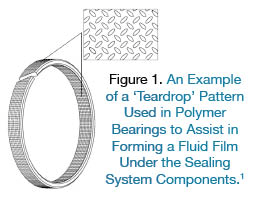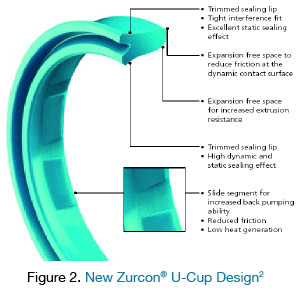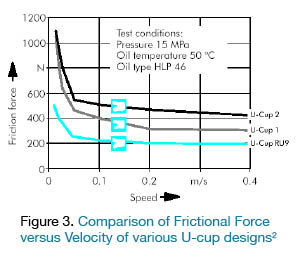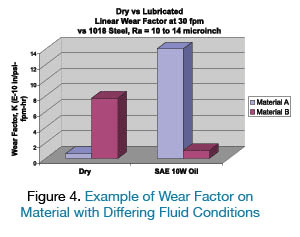The Effects of Hydraulic Cylinders Moving Faster, Stronger, and Longer on Sealing Systems
Mark Sitko and Larry Castleman, Trelleborg Sealing Solutions
Click on images to enlarge.
ABSTRACT
Hydraulic cylinders are being pushed to move faster, use higher pressures, or last longer than ever before. There are the additional requirements of running with higher efficiency and minimizing leakage. These conditions mandate high-performing sealing systems. This paper discusses the effects on sealing systems of cylinders running faster, stronger, and lasting longer and the actions which need to be taken by cylinder manufacturers and sealing system designers in order to develop an optimum solution.
INTRODUCTION
A wide variety of seal and bearing designs exist. When appropriately combined with component layout, mating hardware and operating conditions an effective sealing system can be established. However, market conditions are changing, leading to hydraulic cylinders which must perform in conditions never seen before. Operations in many industries are now asking hydraulic cylinders to move faster, operate under stronger conditions, or last longer than ever before. In addition, societal demands are increasing the requirement for these operations to be done with higher efficiency and with minimal leakage to minimize any impact to the environment. These conditions mandate high-performing sealing systems, which still need to meet the customer expectations of leakage control, friction, and system cost within the expected life of the cylinder. This requires careful consideration during the design stage by both cylinder and sealing system design personnel of the effect that faster movement, longer life, or strong working conditions have on sealing systems in order to reach the desired performance and cost objectives for the cylinder. This paper will examine in more detail what should be carefully considered for each situation of moving faster, lasting longer or operating under stronger conditions.
MOVING FASTER
Faster movement can have a variety of meanings:
• High speeds of extension or retraction rates
• Increased number of cycles in a given time
• Less dwell time between extension and retraction
• Increased acceleration and/or deceleration rates
All of these scenarios have an effect on the sealing system. They produce the potential for higher heat, more wear, pressure buildup, and dynamic events, all of which all must be addressed in order to create an optimum solution.
HIGHER HEAT – As systems move faster, higher heat is generated that affects the sealing system and thus the hydraulic cylinder. This heat can be generated from
• The dynamic effect of the seal or bearing in contact with the rod or housing, which typically worsens with higher velocities
• The valving needed to move the cylinder faster
• The fluid, which has less time to cool
• Fluid breakdown or viscosity changes in the fluid
• Fluid routing
Higher heat resulting from moving faster ultimately adversely affects the hydraulic cylinder and the sealing system. For sealing systems, higher heat affects the friction, leakage control, and life of the sealing system. For the cylinder, the effect is on position control, energy consumption, life, and overall cost for a cylinder. Position control is affected by changes in the sealing system performance, which causes the feedback system to generate overshoot or undershoot. Pumps need to work harder due to changes in viscosity of the fluid and changes in sealing system performance causing decreased efficiency and thus higher energy consumption. Life of the cylinder is linked to life of the sealing system life, which is affected by higher heat. Cost is affected by system life or downtime, decreased performance, and increased energy consumption.
In order to minimize the effects of higher heat, initially there are two independent routes taken, one by the cylinder manufacturer to reduce the heat and the other by the sealing system supplier to both reduce and minimize the effects of higher heat.
For a cylinder manufacturer, ensuring alignment to allow more uniform loading on the sealing system, minimizing additional heat sources, maximizing fluid cooling, and ensuring adequate fluid exchange near the seal are the first steps to minimize higher heat around the sealing system.
Typical actions from sealing system suppliers would be to investigate the bearings and seals.
 Bearings - For bearings, the main target is to ensure that the design, material, and its location relative to the seals will be able to handle the heat, limit the amount of additional heating coming from the friction of the bearing itself, provide the necessary support for the seals, potentially aid in forming a fluid film under the seal, and stay within the system cost targets. See Fig. 1 for an example of a “teardrop pattern” used in some polymer bearings to assist in forming a fluid film under sealing system components.
Bearings - For bearings, the main target is to ensure that the design, material, and its location relative to the seals will be able to handle the heat, limit the amount of additional heating coming from the friction of the bearing itself, provide the necessary support for the seals, potentially aid in forming a fluid film under the seal, and stay within the system cost targets. See Fig. 1 for an example of a “teardrop pattern” used in some polymer bearings to assist in forming a fluid film under sealing system components.
Seals - For seals, the main emphasis is to investigate the use of materials and designs that will handle the increased heat, and a secondary effort would be to lower the friction to decrease the temperature near the seal. Ways of doing this are to reduce seal contact stress, change the design to allow for a different footprint, adjust fluid film under the seal, or change the material.
 One example, which illustrates incorporating all four changes, is a newly designed U-Cup (Fig. 2). It shows a new U-Cup design that offers increased temperature capability and lower friction compared to a standard U-Cup. This seal also contains a micro-structure combined with back-pumping channels on the dynamic seal slide segment that ensure a constant lubrication film underneath the seal sliding surface and back-pumping across its entire pressure range. This reduces friction and thus temperature near the seal. Tests have shown that at higher speeds this design produced less friction compare to other designs (Fig. 3).
One example, which illustrates incorporating all four changes, is a newly designed U-Cup (Fig. 2). It shows a new U-Cup design that offers increased temperature capability and lower friction compared to a standard U-Cup. This seal also contains a micro-structure combined with back-pumping channels on the dynamic seal slide segment that ensure a constant lubrication film underneath the seal sliding surface and back-pumping across its entire pressure range. This reduces friction and thus temperature near the seal. Tests have shown that at higher speeds this design produced less friction compare to other designs (Fig. 3).
 Although the sealing supplier and cylinder manufacturer can work independently to minimize the effect of higher heat being generated from systems running faster, there needs to be more of a team approach to optimize the solution. The sealing system is more than just seals and bearings. It also encompasses component layout, mating hardware conditions, and operating conditions.
Although the sealing supplier and cylinder manufacturer can work independently to minimize the effect of higher heat being generated from systems running faster, there needs to be more of a team approach to optimize the solution. The sealing system is more than just seals and bearings. It also encompasses component layout, mating hardware conditions, and operating conditions.
Here are some examples of needed cooperation between the sealing system supplier and cylinder manufacturer to develop an optimized solution for applications with higher heat:
• Ensuring proper surface finish. Inappropriate surface finish will not allow an adequate fluid film under the seal and thus heat generation. Too smooth of a surface finish will not allow a sufficient fluid film under seals, while too rough will cause the seal to initially ride on the surface finish peaks and will either change the surface finish or the seal. This may also result in higher wear, increased friction, reduced life, or increased leakage.
• Ensuring proper rod hardness and/or surface coating. Rod hardness and surface coatings have to be adjusted with surface finish. Too soft of a rod and/or insufficient coating thickness will potentially allow the seal to engage more into the rod, potentially altering the surface finish. Too hard of a surface may potentially damage the seal.
• Maximizing the load distribution on the bearing. Too high of unit loading will add to the system heat and limit life. Overall packaging envelope needs to be considered when determining proper bearing width and spacing.
• Changing lubrication pattern underneath the bearings. Adding grooves, cavity, patterns, or splitting the bearing will change lubrication pattern. This can assist in minimizing the frictional heat generation from the bearings and help keep a good fluid film for the seal to ride on. However, the cost to add the above features may increase.
• Understanding spacing and location of the bearing relative to the seals. Unsuitable location will not allow adequate support for alignment and will result in higher local loading of the sealing components, thus higher heat.
• Understanding sealing system component layout and the effect on fluid film thickness to reduce friction. To reduce heat, the seals need to ride on a thick fluid film, which can be back-pumped back into the system. Too few or inappropriate components can lead to leakage or increase friction or pressure buildup, while too many components will result in unwanted cost and unnecessary heat from friction.
• Understanding fluid conditions. Changes in viscosity and potential fluid breakdown affect the fluid film, which the seals ride on. Too thin of a fluid film resulting from viscosity changes or fluid breakdown will result in higher heat generation and friction. Contrarily, too thick of a fluid film may result in excess leakage.
• Understanding potential hardware dynamics. The potential for hardware ballooning due to thermal expansion or bending due to heat needs to be accounted for as it changes the contact stresses of the seal, which will affect the fluid film thickness. Other hardware dynamics due to heat such as softening the support for the bearing or the bearings themselves will limit the load capability of the bearing and change unit loading of the bearings also needs to be addressed.
The above cannot be done solely by the cylinder manufacturer or sealing supplier, but only through cooperation. As leakage, friction, life, and overall system cost are interrelated for a sealing system, these factors need to be taken into account as each of the above items are reviewed to achieve the necessary balance for an optimized solution.
WEAR – Higher wear is associated with faster cylinder movement. This higher wear can be caused by
• The time related dynamic effect of the seal or bearing in contact with the rod or housing
• Poor lubrication conditions
• The increased impact of contaminates in the system
• Increased wear caused by higher heat changing the material properties
Similar to what was discussed under the Higher Heat section related to moving the cylinder faster, wear adversely affects the position control, energy consumption, life, and overall cost of a cylinder. Relative to the sealing system, wear affects the friction, leakage control, and life. Cost could be an additional effect as wear may be severe enough to damage both sealing system components and mating surface hardware.
As in the prior section, two independent routes can be taken, one by the cylinder manufacturer and other by the sealing system supplier. For cylinder manufacturers, ensuring alignment and removing heat as addressed previously will have a benefit to reducing wear. Also, minimizing contamination in the systems to reduce impact effects due to the momentum of the particles, tightening tolerances to narrow the variations, which the sealing system needs to compensate for, and minimizing conditions such as hold under pressure and dithering, where the seal is put in conditions of poor fluid film under the seal, will have a positive effect.
 For sealing system suppliers, the same basics applied to reducing the effects of higher heat also apply to reducing wear. However, when reviewing designs and materials, wear resistance instead of temperature capability is the desired characteristic. Characterizing for wear is significantly more complicated as wear is a function of surface finish, running surface hardness, fluid, material, design, velocity, temperature, and loading. These factors must all be included in the testing in order to create meaningful data on wear characteristics of materials and products. Fig. 4 shows some typical test results on materials in two operating conditions, with the only change being the fluid conditions the samples were run in. As the operating conditions change, the wear factor can be completely different when comparing materials, and thus the choice of material may change. This information needs to further reviewed with product design, system component layout, operating conditions, and mating hardware as material is just one part of creating an effective sealing system.
For sealing system suppliers, the same basics applied to reducing the effects of higher heat also apply to reducing wear. However, when reviewing designs and materials, wear resistance instead of temperature capability is the desired characteristic. Characterizing for wear is significantly more complicated as wear is a function of surface finish, running surface hardness, fluid, material, design, velocity, temperature, and loading. These factors must all be included in the testing in order to create meaningful data on wear characteristics of materials and products. Fig. 4 shows some typical test results on materials in two operating conditions, with the only change being the fluid conditions the samples were run in. As the operating conditions change, the wear factor can be completely different when comparing materials, and thus the choice of material may change. This information needs to further reviewed with product design, system component layout, operating conditions, and mating hardware as material is just one part of creating an effective sealing system.
An optimized sealing system is a joint effort between the cylinder manufacturer and sealing system supplier. There are joint activities that need to be done to reduce the impact of wear on the sealing system caused by cylinders moving faster. The same joint activities that were stated in the “Higher Heat” section can also be applied to reduce the impact of wear:
• Ensuring proper surface finish
• Ensuring proper rod hardness and/or surface coating
• Maximizing the load distribution on the bearing
• Changing lubrication pattern underneath the bearings
• Understanding spacing and location of the bearing relative to the seals
• Understanding sealing system component layout and the effect on fluid film thickness to reduce friction
• Understanding fluid conditions
• Understanding potential hardware dynamics